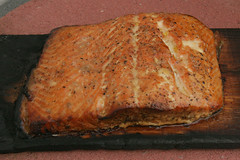Salmon live in both the Atlantic and Pacific Oceans, as well as the Great Lakes.
Typically, salmon are anadromous: they are born in fresh water, migrate to the ocean, then return to fresh water to reproduce.
Freshwater streams and estuaries provide important habitat for many salmon species. They feed on terrestrial and aquatic insects, amphipods, and other crustaceans while young, and primarily on other fish when older, says Wikipedia.
Salmon is a popular food. Classified as an "oily fish",[9] salmon is considered to be healthy due to the fish's high protein, high Omega-3 fatty acids, and high vitamin D[10] content. According to reports in the journal Science, however, farmed salmon may contain high levels of dioxins. PCB (polychlorinated biphenyl) levels may be up to eight times higher in farmed salmon than in wild salmon. Nonetheless, according to a 2006 study published in the Journal of the American Medical Association, the benefits of eating even farmed salmon still outweigh any risks imposed by contaminants.
The population of wild salmon declined markedly in recent decades, especially north Atlantic populations which spawn in the waters of western Europe and eastern Canada, and wild salmon in the Snake and Columbia River system in northwestern United States.
- Overfishing in general.
- Ocean and river warming.
Salmon aquaculture represents over $1 billion US annually. Other commonly cultured fish species include: tilapia, catfish, sea bass, carp, bream, and trout.
Salmon farming is very big in Chile, Norway, Scotland and Canada and is the source for most salmon consumed in America and Europe.
skip to main |
skip to sidebar
For students and parents who love education and exploration of the social sciences . . .
Search This Blog
Followers
Blog Archive
-
▼
2009
(379)
-
▼
October
(49)
- No school on Fri in Caddo-Bossier, says KTBS news
- The movie "Master and Commander; Far Side of the W...
- Brazil: Portuguese-speaking, multi-ethnic land of ...
- Review questions on Brazil
- Brazil: comparison research on a vibrant South Ame...
- Magnet Drama Day is Friday
- Indie work: comparing successful Mexicans Frida Ka...
- South America in Upfront magazine: the top 5 nations
- Mexico: the Tenochtitlan Quiz
- What we shall be singing on Dia de los Muertos: "l...
- The Spanish Empire project on Wed, Oct 21
- From Mexico to Spain: follow the money
- How the work of the Conquistadors lead to the Atla...
- The feathered serpent: Quetzalcoatl
- Mesoamerican technology: the remarkable Aztec cale...
- Capital of the Aztecs: Tenochtitlan
- The Aztec glyph for movement
- Aztecan divine bird: the Resplendent Quetzal
- Mon: The Blue Planet / Coral seas
- Barracuda & shark
- Developments credited to the Aztecs
- Hecho en Mexico: Chiclets
- Ancient Mexican craft: papel picado
- Calaveros, calacos, catrina, ofrendas, papel picad...
- Map quiz, Mexico, next Thurs: 12 items
- Money for Myrtles project up to $203.56 in donatio...
- Semester Projects: Social Studies Fair Team & Topi...
- Cmh13.com: another way to connect with your classm...
- Mexico project Uno
- Genealogy and America: the roots of Michelle LaVau...
- Lungi: a man-skirt retained from the ancient days ...
- We measure things oddly; we look at feet and miles...
- Maple Leaf Quiz / Geography Open Notes review # 6
- Mexico City profile from About.com
- The geography class Open Notes quiz is based on we...
- Dancing house Gecko
- Salmon: global resource that is important to Canad...
- Vancouver to Quebec: a review of Canada
- Three cacophonous cities / geography quiz 5
- Quiz on Th, Oct 8: map of Canada and open notes qu...
- Brief reports on GoogleDocs comparing one facet of...
- Oct 5 / this week: Canada vs Mexico
- Red River Revel: Sat, Oct 3, to Sat, Oct 10
- Vieux Montreal has been called Petit Paris
- Canada's most populous city: Toronto
- The high-tech, Asian and diverse Canadian city on ...
- Famous Canadians in New Orleans' French Quarter: B...
- The simplified Regional US: what is the Midwest?
- The Ethicist: a columnist answers questions about ...
-
▼
October
(49)

